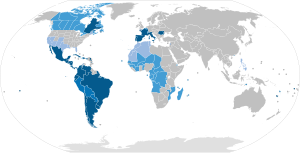This article has multiple issues. Please help improve it or discuss these issues on the talk page. (Learn how and when to remove these messages)
|
| Romance | |
|---|---|
| Latin/Neo-Latin | |
| Geographic distribution | Originated in Old Latium on the Italian peninsula, now spoken in Latin Europe (parts of Eastern Europe, Southern Europe, and Western Europe) and Latin America (a majority of the countries of Central America and South America), as well as parts of Africa (Latin Africa), Asia, and Oceania. |
| Linguistic classification | Indo-European
|
Early forms | |
| Proto-language | Proto-Romance |
| Subdivisions | |
| Language codes | |
| ISO 639-2 / 5 | roa |
| Linguasphere | 51- (phylozone) |
| Glottolog | roma1334 |
 Romance languages in Europe | |
 Romance languages globally
Majority native language
Co-official and majority native language
Official but minority native language
Cultural or secondary language | |
| Part of a series on |
| Indo-European topics |
|---|
 |
The Romance languages, also known as the Latin[1] or Neo-Latin[2] languages, are the languages that are directly descended from Vulgar Latin.[3] They are the only extant subgroup of the Italic branch of the Indo-European language family.
The five most widely spoken Romance languages by number of native speakers are:
- Spanish (489 million): the official language in Spain, Mexico and most of Central and South America
- French (321 million): official in 29 countries[4]
- Portuguese (240 million): official in Portugal, Brazil and Portuguese-speaking Africa[5]
- Italian (67 million): official in Italy, Vatican City, San Marino, Switzerland; minority language in Croatia; regional in Slovenia (Istria) and Brazil (Santa Teresa, Espírito Santo and Encantado, Rio Grande do Sul)[6][7]
- Romanian (25 million): official in Romania, Moldova[8] and the Autonomous Province of Vojvodina in Serbia; minority language in Hungary, the rest of Serbia and Ukraine.
The Romance languages spread throughout the world owing to the period of European colonialism beginning in the 15th century; there are more than 900 million native speakers of Romance languages found worldwide, mainly in the Americas, Europe, and parts of Africa. Portuguese, French and Spanish also have many non-native speakers and are in widespread use as lingua francas.[9] There are also numerous regional Romance languages and dialects. All of the five most widely spoken Romance languages are also official languages of the European Union (with France, Italy, Portugal, Romania and Spain being part of it).
- ^ "Latin". Merriam-Webster.com Dictionary. Archived from the original on 2023-06-10. Retrieved 2023-11-03.
- ^ "Neo-Latin". Merriam-Webster.com Dictionary. Archived from the original on 2023-04-25. Retrieved 2023-11-03.
- ^ Herman, József; Wright, Roger (2000). Vulgar Latin. University Park: Pennsylvania State University Press. pp. 96–115. ISBN 0-271-02001-6.
- ^ "French Speaking Countries List | Lingoda Live Language Education Online".
- ^ "The World Factbook World". The World Factbook. CIA (US). Retrieved 14 November 2023.
- ^ "Lei n. 5.048/2023 - Do Município de Encantado / RS". Archived from the original on 11 August 2024. Retrieved 11 August 2024.
- ^ "Lei n. 2.812/2021 - Do Município de Santa Teresa / ES". Archived from the original on 11 August 2024. Retrieved 11 August 2024.
- ^ Moldovan is a language very similar to Romanian, usually combined with Romanian
- ^ M. Paul Lewis, "Summary by language size Archived 2013-02-02 at the Wayback Machine", Ethnologue: Languages of the World, Sixteenth Edition.